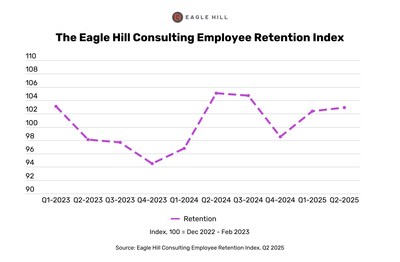Workforce Signals Retention Stability, While Market Uncertainty Deepens
Job Market Confidence Among Workers Sees Sharp Decline
Gen Z Workers Remain Most Likely to Stay In Jobs, But Signal Attrition Risk
ARLINGTON, Va., July 24, 2025 /PRNewswire/ — The latest Eagle Hill Consulting Employee Retention Index continues an upward trend, rising by 0.4 points to 102.9, signaling that workers likely will remain in their jobs over the next six months. Importantly, the Retention Index measures a sharp decline in employees’ perceptions of the external job market. The Market Opportunity Indicator dropped by 4.4 points, the steepest decline since the Index’s inception in 2023 and now sitting at its lowest recorded level.
The latest Eagle Hill Consulting Employee Retention Index continues an upward trend, rising by 0.4 points to 102.9, signaling that workers likely will remain in their jobs over the next six months.
This Market Opportunity decline reflects a growing sense of pessimism that employees hold about employment opportunities outside of their current organizations. Across the four indicators — Culture, Compensation, Organizational Confidence, and Job Market Opportunity — market sentiment not only experienced the greatest loss, but now is the lowest-ranking sentiment influencing employees’ intent to stay or leave their current roles.
Across the four indicators — Culture, Compensation, Organizational Confidence, and Job Market Opportunity — market sentiment not only experienced the greatest loss, but now is the lowest-ranking sentiment influencing employees’ intent to stay or leave their current roles.
The Market Opportunity Indicator dropped by 4.4 points, the steepest decline since the Index’s inception in 2023 and now sitting at its lowest recorded level.
These results follow the latest U.S. Bureau of Labor Statistics (BLS) jobs report. While the report found that hiring has remained solid in June, economists and analysts were cautious about growth and jobs going forward. For example, the BLS data found private sector job growth fell to the lowest level since October 2024 and nearly half of the of the 147,000 total new jobs added in June were in state and local government. The BLS data also found more than half of private industries cut jobs in June, marking only the third time this has happened since April 2020. Additionally, the most recent Job Openings and Labor Turnover Survey found 5.5 million hires were made during May, down from the 5.61 million in April.
“Eagle Hill’s Job Market Opportunity Indicator plunge is more than just a data point: it marks the first time this indicator has declined for two consecutive periods, now at its lowest point since we launched the Index,” said Melissa Jezior, president and chief executive officer of Eagle Hill Consulting. “This significant drop is echoed across almost every demographic, with Baby Boomers experiencing the most significant fall, followed by men.”
“This convergence highlights that worker confidence in job opportunities is dwindling for nearly all U.S. workers as uncertainty looms around the broader economic outlook and job threats like AI and automation. Organizations, however, can leverage this drop in market confidence as a window of opportunity. While employees may feel less inclined to leave their current roles, they may also be more open to new roles or training,” Jezior said.
Story Continues
